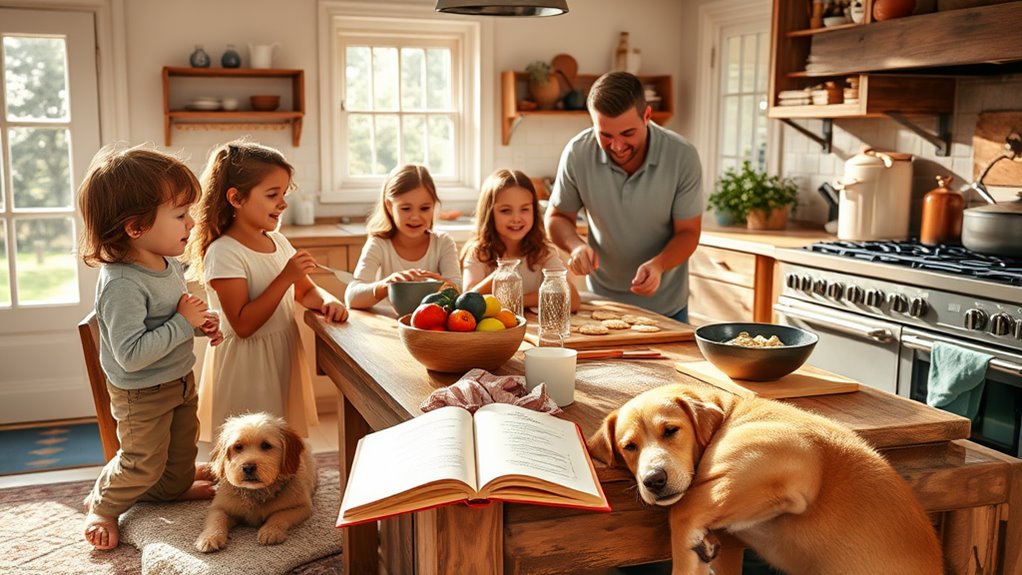How Family Routines Can Help You Create a Happy Home
Family routines can transform your home into a happy space by providing stability and reducing chaos. When you establish consistent patterns, like dedicated family game nights or regular meal prep, you clarify expectations and create security for everyone, especially kids. These routines promote responsibility and enhance communication, strengthening family bonds. You don’t have to start big; begin with small rituals that everyone can enjoy. Celebrate the little successes along the way to boost participation. By embracing routines, you’ll foster a joyful atmosphere where everyone feels connected. Discovering more about effective routines can further enrich your family life.
Key Takeaways
- Family routines establish stability, reducing chaos and clarifying expectations for all household members.
- Regular bonding activities strengthen family ties and enhance communication among members.
- Defined roles and tasks within routines promote responsibility and accountability in children.
- Incorporating simple rituals fosters anticipation and togetherness, enriching daily family experiences.
- Consistent routines lead to improved engagement and satisfaction, contributing to overall family happiness.
Benefits of Family Routines
When you establish family routines, you create a sense of stability that benefits everyone in your household. Routines help reduce chaos and uncertainty, giving each family member a clear understanding of what to expect. This predictability fosters security, especially in children, who thrive in structured environments.
Additionally, by regularly engaging in family activities, you strengthen bonds and enhance communication. Routines also promote responsibility, as each person learns their role and tasks within the family dynamic.
Over time, these habits can lead to improved time management and reduced stress, creating a more harmonious atmosphere. Ultimately, family routines lay the groundwork for a supportive environment, allowing everyone to flourish and feel valued in their unique contributions.
Types of Effective Routines
Establishing family routines can take many forms, each tailored to fit your family’s needs and lifestyles.
Here are some effective types of routines you can implement:
-
Morning Routines: Start your day with a consistent schedule that includes breakfast, getting dressed, and packing for school or work.
-
Meal Prep Routines: Designate specific days for grocery shopping and meal preparation, making mealtimes smoother and more enjoyable.
-
Family Activities: Set aside regular time for family bonding, like game nights or outdoor activities, to strengthen connections.
-
Bedtime Routines: Create a calming end-of-day ritual that includes winding down, reading, and reflecting on the day, ensuring everyone gets quality sleep.
Incorporating these routines can lead to a more organized and joyful home environment.
Incorporating Rituals Into Daily Life
Incorporating rituals into your daily life can transform ordinary moments into meaningful experiences. Start small by establishing simple rituals that fit your family’s routine. For instance, you might have a special breakfast on Sundays or a nightly storytime before bed.
These practices create a sense of togetherness and anticipation. You can also celebrate small achievements, like completing a project or reaching a goal, with a family high-five or a unique dessert.
Consider using mealtime as a chance to share highlights from your day, fostering open communication. By embedding these rituals into your schedule, you’ll not only strengthen family bonds but also cultivate joy and appreciation for the little moments that make life special.
Embrace these practices, and watch your family flourish.
Overcoming Challenges in Implementation
Although implementing family routines can bring immense joy, it often comes with its share of challenges. You might face resistance from family members or struggle to find the right time.
Here are some tips to help you overcome these hurdles:
-
Start Small: Begin with one simple routine. This makes it easier for everyone to adapt.
-
Involve Everyone: Get input from all family members. When they feel included, they’re more likely to embrace the routine.
-
Stay Flexible: Life can be unpredictable. Be ready to adjust routines as needed without frustration.
-
Celebrate Successes: Acknowledge when routines go well. This positive reinforcement encourages everyone to keep participating.
Measuring Success and Happiness
Once you’ve navigated the challenges of implementing family routines, the next step is to assess how these changes impact your family’s happiness.
Start by observing your family’s interactions. Are conversations more meaningful? Are your kids more engaged during activities? These are signs your routines are working.
You can also check in with each family member. Ask how they feel about the routines and if they enjoy the time spent together.
Consider tracking small milestones, like happier mealtimes or smoother bedtime routines, as indicators of progress.
Frequently Asked Questions
How Can Family Routines Improve Communication Among Family Members?
Family routines foster regular interaction, helping you all share thoughts and feelings more openly. When you establish consistent times for meals or activities, it creates a safe space where everyone feels heard and valued.
What Age Is Best to Start Family Routines With Children?
You can start family routines as early as infancy. Children thrive on consistency, and establishing routines helps them feel secure. As they grow, you can adapt these routines to fit their evolving needs and interests.
How Do Family Routines Affect Individual Family Members’ Mental Health?
Family routines provide structure, reducing stress and anxiety for everyone. You’ll find that predictability fosters a sense of safety, enhancing individual well-being. Regular interactions during these routines strengthen bonds, supporting each family member’s mental health positively.
Can Family Routines Be Adapted for Blended Families?
Absolutely, you can adapt family routines for blended families! Start by incorporating everyone’s preferences, communicate openly, and guarantee each member feels included. Flexibility and understanding will help create a harmonious environment for everyone involved.
What Are Some Examples of Spontaneous Routines?
Spontaneous routines can include impromptu movie nights, surprise picnic lunches, or weekend adventure trips. You’ll find joy in these unplanned moments, strengthening your bonds and creating lasting memories with your family while enjoying the unexpected together.



